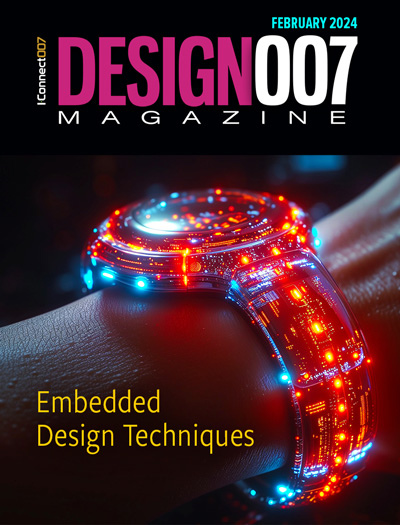-

- News
- Books
Featured Books
- design007 Magazine
Latest Issues
Current Issue
Level Up Your Design Skills
This month, our contributors discuss the PCB design classes available at IPC APEX EXPO 2024. As they explain, these courses cover everything from the basics of design through avoiding over-constraining high-speed boards, and so much more!

Opportunities and Challenges
In this issue, our expert contributors discuss the many opportunities and challenges in the PCB design community, and what can be done to grow the numbers of PCB designers—and design instructors.

Embedded Design Techniques
Our expert contributors provide the knowledge this month that designers need to be aware of to make intelligent, educated decisions about embedded design. Many design and manufacturing hurdles can trip up designers who are new to this technology.
- Articles
- Columns
Search Console
- Links
- Events
||| MENU - design007 Magazine
Just Ask Joe: Standardized Grid Designs
August 26, 2020 | I-Connect007 Research TeamEstimated reading time: 2 minutes
First, we asked you to send in your questions for Happy Holden. Now, it’s Joe Fjelstad’s turn! Inventor, columnist, instructor, and founder of Verdant Electronics, Joe has been involved with rigid PCBs and flexible circuits for decades, and he’s ready to share some of his knowledge with our readers. We hope you enjoy “Just Ask Joe.”
Q: Will standardized grid designs ever come to fruition?
A: I am old enough to know that once upon a time, the electronics industry actually had a standardized grid. It was 0.100”. It was the natural by-product of the fact that most early electronic packages were dual in-line packages (DIPs), and nearly all of the first DIPs had their leads on 100-mil pitch (the Soviets and Eastern Bloc nations went with 2.5 mm rather than 2.54 mm or 0.1 inches). It was a natural default, and 100-mil grid pitch design was common and the standard even today; think of hobbyist’s bread boards, which are on a 100-mil grid.
Those halcyon days were disrupted as pin counts rose, and surface-mount technology took the stage to help manage the explosion in package pin counts. Then there was the “80% rule” for package leads that took effect to provide a defined roadmap for following generation component lead pitch. Thus, today (ignoring inch-based devices), we have 2.5 mm, 2.0 mm, 1.5 mm, 1.25 mm, 1.0 mm, 0.8 mm, 0.65 mm, 0.5 mm, 0.4 mm, etc.
Area array technology offered the opportunity to return to a standard grid, but the 80% rule was applied instead, which is a great pity from my perspective. Instead, what might have been done is to agree on a common base grid pitch and depopulate to the pin count desired. Everything gets easier again—no more burning off layers of circuits to accommodate escapes and differing grid pitch components. It is an easy way to return to standardized grids. All that is necessary is for component packagers to offer every component with terminations on a standard grid. My suggestion is 0.5 mm because that is where component soldering yields start to fall off.
Is it possible to return to the standard grid? Absolutely. It is more a question of customer demand for such and package foundries’ willingness to do so. It could save billions of dollars annually, according to my back-of-the-napkin calculations.
To pose your own question for Joe Fjelstad, click here.
Joe Fjelstad is founder and CEO of Verdant Electronics and an international authority and innovator in the field of electronic interconnection and packaging technologies with more than 185 patents issued or pending. To read past "Flexible Thinking" columns or contact Fjelstad, click here. Download your free copy of Fjelstad’s book Flexible Circuit Technology, 4th Edition, and watch the micro webinar series on flexible circuit technology.
Suggested Items
Warm Windows and Streamlined Skin Patches – IDTechEx Explores Flexible and Printed Electronics
04/26/2024 | IDTechExFlexible and printed electronics can be integrated into cars and homes to create modern aesthetics that are beneficial and easy to use. From luminous car controls to food labels that communicate the quality of food, the uses of this technology are endless and can upgrade many areas of everyday life.
Book Excerpt: The Printed Circuit Assembler’s Guide to... Factory Analytics
04/24/2024 | I-Connect007 Editorial TeamIn our fast-changing, deeply competitive, and margin-tight industry, factory analytics can be the key to unlocking untapped improvements to guarantee a thriving business. On top of that, electronics manufacturers are facing a tremendous burden to do more with less. If you don't already have a copy of this book, what follows is an excerpt from the introduction chapter of 'The Printed Circuit Assembler’s Guide to... Factory Analytics: Unlocking Efficiency Through Data Insights' to whet your appetite.
Listen Up! The Intricacies of PCB Drilling Detailed in New Podcast Episode
04/25/2024 | I-Connect007In episode 5 of the podcast series, On the Line With: Designing for Reality, Nolan Johnson and Matt Stevenson continue down the manufacturing process, this time focusing on the post-lamination drilling process for PCBs. Matt and Nolan delve into the intricacies of the PCB drilling process, highlighting the importance of hole quality, drill parameters, and design optimization to ensure smooth manufacturing. The conversation covers topics such as drill bit sizes, aspect ratios, vias, challenges in drilling, and ways to enhance efficiency in the drilling department.
Elevating PCB Design Engineering With IPC Programs
04/24/2024 | Cory Blaylock, IPCIn a monumental stride for the electronics manufacturing industry, IPC has successfully championed the recognition of the PCB Design Engineer as an official occupation by the U.S. Department of Labor (DOL). This pivotal achievement not only underscores the critical role of PCB design engineers within the technology landscape, but also marks the beginning of a transformative journey toward nurturing a robust, skilled workforce ready to propel our industry into the future.
Winner of The Science Show Rakett 69 Receives Incap Scholarship
04/24/2024 | IncapThe winner of the Rakett 69 science show, Andri Türkson, who stood out as an electronics enthusiast, received a scholarship from Incap Estonia, along with an internship opportunity in Saaremaa.


